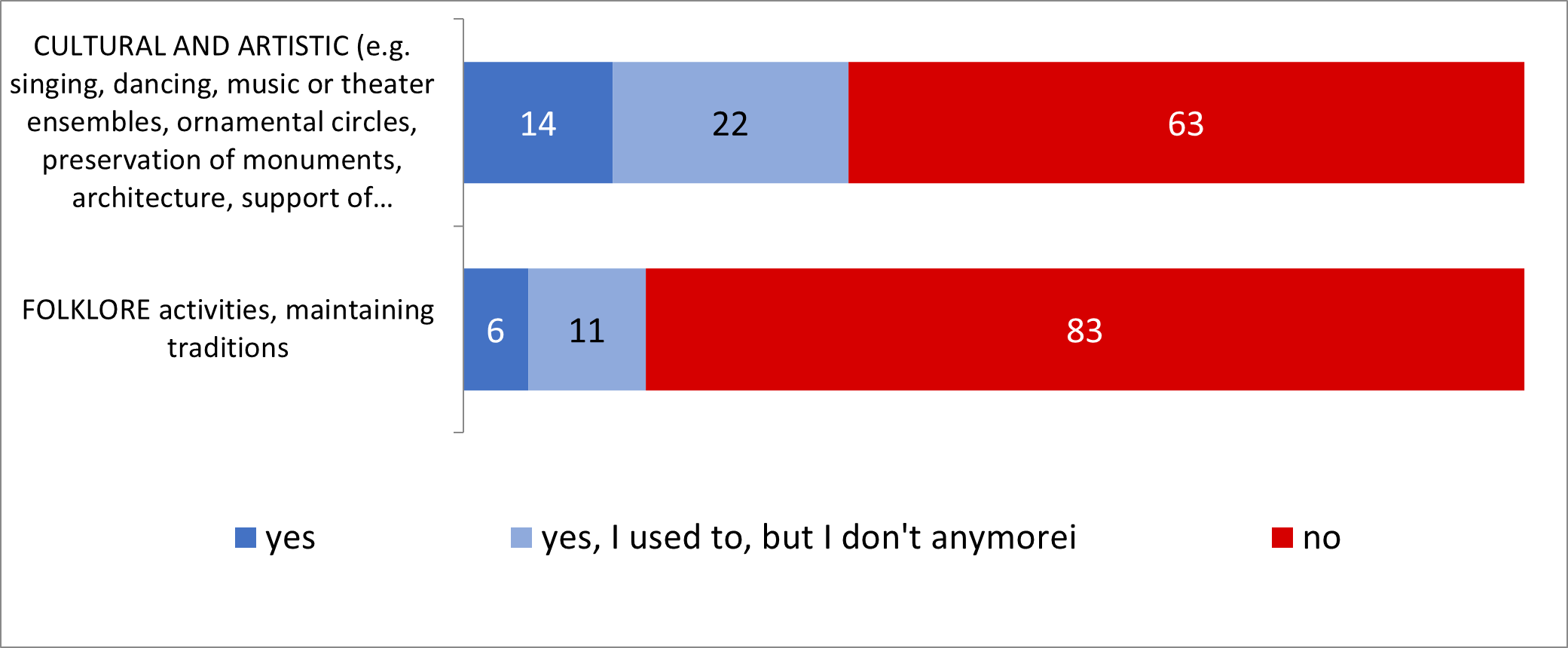8.1 General context
On this page
On this page
Main trends in young people's creativity and cultural participation
However, young people are an important target group of cultural policies of the Czech Republic, there are no national longitudinal data monitoring youth participation in cultural activities. However, there are several studies or surveys on ad hoc bases or in wider academic research.
Czech Statistical Office cooperates on the data collection on culture with NIPOS (National Information and Consulting Centre for Culture), the National Library and Ministry of Culture as in State Statistical Service. However, young people are not a special focus in this service. Experts from the Statistical Office declare that the statistics in culture is one of the most complicated and problematic. Official cultural statistics focus only on professional activities and non-professional activities, thus mainly including youth cultural activities are not monitored officially
The Czech Statistical Office provides relevant data on cultural participation only within a special module added to the EU-SILC national implementation (Výběrové šetření Životní podmínky). This basic module was realised in 2006 and 2015.
Based on the data provided from 2015 we can assume for the age cohort 16-30 years that:
Around 5 to 6 % of young people could not afford to participate in basic cultural activities such as visiting the cinema, theatre or cultural heritage sites in last 12 months. For sports events, it was a bit more, around 8 %. Around 9% of young people go to the cinema, theatre, cultural heritage sites or sports events at least 1 to 3 times a year. Approximately 17 % of young people visit the cinema more than 3 times a year, compared to the theatre at 9 %, cultural heritage sites at 7-8 % and sports events at 11%. No interest in such activities was shown by only about 2 % for the cinema, 6 % for theatre and cultural heritage sites and around 5 % for sports events. In terms of sports events, we see that with higher ages, the interest lowers. In the age group 16-20 years only around 3 % were not interested, in the age group 26-30 it was up to 6 %. The survey also showed that with higher age groups, the interest in active cultural participation lowers. In the age group 15-24 years, 39 % performed some cultural activity at least once a year. For persons over the age of 45, it was below 30 %.
Based on the data (2020) of the Czech Council of Children and Youth, we have found that a significant number of young people read books, 17% even every day. Visits to museums, galleries, concerts of serious or pop music are no longer so attractive, yet approximately two-fifths of young people engage in these activities at least once a quarter. Women read books daily significantly more often than men (19 vs. 8%). The level of educational attainment turns out to be crucial in the interest of culture. University students and people with a high school diploma visit theaters, concerts, galleries and museums more often. They also read significantly more often. 46% of young people with completed university education read daily or at least once a week. In contrast, this is only the case in 23% of people with a teaching certificate. Prague offers more cultural options, and this is related to the fact that young Praguers visit galleries, museums or theaters more often than in the rest of the country. Members of youth organizations also differ from young people who do not have this experience in many ways. They attend pop, rock or punk concerts significantly more often, with 43% of members doing so at least once a month compared to 16% of non-members. They visit theaters and museums a little more. They are also more avid readers, with 23% of members and only 12% of non-members reading books daily.

More than a third of young people (36%) also have their own experience with cultural and artistic activities. These are various singing, dancing or theater ensembles, etc. Another 17% are or have been engaged in folklore activities. More often, members of youth organizations engage in these cultural activities. Cultural and artistic activities are more typical for women, by about 10%. However, this is not the case with folklore activities. There are noticeable differences only between Bohemia and Moravia. Moravian young people devote themselves to them about 10% more often.

Active learning of cultural activities such as playing a musical instrument, painting, acting or dancing within the scope of Elementary Art Schools (see details below in main concepts) is rising – in school years 2010/11 there were around 235 000 pupils of these schools. In 2015/16 it was already around 247 000, in 2018/19 around 253 500 and in 2019/20 254314. Considering that the total number of children and young people was rather on the decline, we see that a higher proportion of children and young people is interested in art education. There is also easier access of young people to creative learning and culture.
According to the State Cultural Statistics, we can presume that fewer young people (students) are visiting museums and galleries, as there is a rise of persons paying full entry fees contrary to those with discounted tickets (however, the discounts are monitored in total for all entitled groups including students, seniors, handicapped etc. and young people not studying will also be also paying the full entry fee if they do not have a special youth discounts card).
Trends in the cultural theatre infrastructure for children and youth based on the State Cultural Statistics between years 2012-2022:
| 2012 | 2016 | 2018 | 2019 | 2020 | 2021 | 2022 | 2023 | |
| Repertoire of plays in theatre for Children and Youth | 870 | 1 044 | 1 054 | 1 009 | 936 | 871 | 1 034 | 850 |
| Number of performances on a home stage and touring in the Czech Republic | 9 744 | 11 267 | 10 880 | 10 829 | 3 749 | 4 882 | 9 979 | 8140 |
| Number of Premiers for Children and Youth | 196 | 173 | 182 | 171 | 102 | 111 | 170 | 137 |
Main concepts
Cultural policies and their concepts in the Czech Republic are harmonised with the international framework, especially of UNESCO, Council of Europe and the European Union. There are several main concepts, which are country-specific. Among these are Public Cultural Service, Cultural and Creative Industry, the system of Elementary Art Schools and the idea of aesthetic activities of children and youth.
Veřejná kulturní služba (Public Cultural Service)
This is a term used since the 1960s but with a vague definition given in the Act no. 203/2006 Sb. on some kinds of support for culture as follows:
Public cultural services are services consisting of making artistic creation and cultural heritage available to the public and in the acquisition, processing, protection, preservation and disclosure of information that is used to satisfy the cultural, cultural-formative or cultural-educational needs of the public.
KKO – Kulturní a kreativní průmysly (Cultural and Creative Industry)
KKO is a new concept in the Czech Cultural Policy since 2014, which focuses on the economic and social value of creativity and cultural innovations.
The official definition of KKO by the Ministry of Culture:
'KKO includes activities which are based on human creativity, skills and talent. They have the potential to create wealth and jobs, in particular by using intellectual property. They include activities or products of public, non-profit and market subjects, regardless of the type and the method of the financing entity, who performs them. KKO contributes with its added value to other sectors of economic activity and can be a source of technological and non-technological innovation. KKO has many other positive impacts on society and the particular individual.'
Estetické aktivity dětí a mládeže (Aesthetic activities of children and youth)
The cultural sphere (materialised with state organisation NIPOS – for details see Chapter 8.2) operates with the concept or rather the idea of aesthetic activities of children and youth within aesthetic education. It is rather a traditional term used and supported by the state before 1989. However, in the cultural sector, it is a strong concept, even if there is no official definition.

